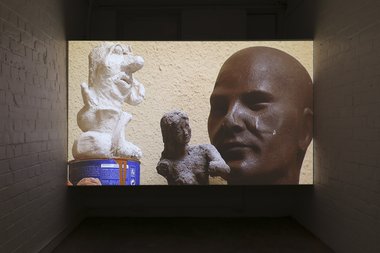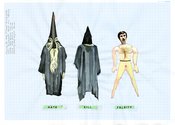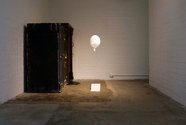John Hurrell – 18 September, 2015
At first glance the three works of de Gruyter and Thys - with their intensely menacing stares and endlessly long confrontational poses - seem grim and unrelentingly dour, except sometimes there is an understated humour that gradually makes itself apparent. Der Schlamm von Branst is quite obviously a lampooning of the exaltation of art, a ridiculing of a sculptor's studio with its various rotating plinths and clay busts.
Auckland
International group exhibition
i) Duplex Cling Mob
Organised by Matt Hanson
26 August - 26 September 2015
Even though there are works from seven assorted artists or ‘art teams’ being presented here - including a wonderful drawing from (Australians) Janet Burchill and Jennifer McCamley looking at a great Sturtevant installation, and really fine works from Campbell Patterson (a towel /sultan bran ‘painting’) and Dan Arps (a cast polyurethane drawer that looks deceptively like red wax) - the real stars of this show put together by Matt Hanson, dominating with three videos in Michael Lett’s downstairs basement, are the Belgian artists Jos de Gruyter and Harald Thys. With their handpicked selection of squinty-eyed glowering actors mingled with stylised tableau vivant thuggery, they effortlessly dominate.
At first glance their three works - with their intensely menacing stares and endlessly long confrontational poses - seem grim and unrelentingly dour, except sometimes there is an understated humour that gradually makes itself apparent. Der Schlamm von Branst is quite obviously a lampooning of the exaltation of art, a ridiculing of a sculptor’s studio with its various rotating plinths and clay busts. The central character is hangdog and pitiful, a sort of gurgling praying priest desperately imploring for energy and inspiration from above, a Joblike figure tormented by bullies wearing ill-fitting blond wigs who come and poke holes in the hollow clay forms.
Het Fregat revolves around a grey model frigate, with intricate sails and rigging that the bored looking protagonists look through and across (balefully) at each other. The various physiognomies have a late medieval look about them, as if from paintings by Bosch or Brueghel. There is definitely a satirical ambience in the style of Ensor and the visages of his mocking group scenes. Ten Weyngaert is partially set in a vineyard where Lynchian personages scurry around at night, spying on each other through the grapeladen fences, and where Tom and Tim, malicious repairmen in blue overalls and caps employed by the local gangster, rough up anybody wearing a sportscoat or slacks.
The humour of de Gruyter and Thys is (I suspect) related to the humour of someone like say, Finnish director Aki Kaurismaki with his Leningrad Cowboy movies, but more ostensibly brutal and despairing. It is deadpan and confrontational, so that with the depicted conflict you have to decide if the scenario is motivated by humour or drama that implies an escalating terror. It is exciting to see this intense but unusually unhistrionic Belgian work in a local Auckland dealer gallery.
John Hurrell









 Two Rooms presents a program of residencies and projects
Two Rooms presents a program of residencies and projects Advertising in this column
Advertising in this column



This Discussion has 0 comments.
Comment
Participate
Register to Participate.
Sign in
Sign in to an existing account.